Feature stories, read aloud: Download the Audm app for your iPhone.

To be fully honest, the decision to buy an old car, have it reconfigured to demolition derby standards, and then drive in a derby myself traces back to a night of crisis in Iowa—though not a political crisis, as one might assume. It was 2002, and I was dating a poet. That’s a crisis in and of itself, but on this particular night the poet had convinced herself that her life was wrecked—it’s a common poetic affliction—and she was inconsolable until we embarked on a brief, ironic road trip to What Cheer, a small town whose broke-down squalor was representative of the fate that had befallen small towns all across Iowa, all across the country, really. We had no plan other than to find a diner, have a piece of pie, and let whatever remained of What Cheer’s lingering charms cure the poet’s chronic malaise.

(Photo: Jerome Sessini/Magnum Photos)
It came as a complete surprise when we rolled into town well after dusk and saw a portion of the horizon lit up as if to act as a beacon to a friendly alien spaceship. We headed toward the light, coasting past the crumbling columns of the once stately What Cheer Christian Church and the mostly boarded-up downtown. The glow wasn’t E.T. Rather, we had stumbled onto What Cheer’s figure-eight dirt-track demolition races. The poet and I climbed up into a rickety bandstand just in time to witness a number of good crashes, vehicles vaulting about and occasionally smashing into one another in what served as an alarmingly straightforward demonstration of how aggression drains angst. After a time, it became apparent that the violence of the wrecks acted as a purgative to that tiny community’s economic purgatory, just as surely as it flushed away the poet’s corrosive mood.
I. AN APOCRYPHAL HISTORY
The creation myth of demolition derby dates to 1958, when Long Island stock-car driver Lawrence Mendelsohn flipped his ’49 Ford and sailed 12 rows up into an empty grandstand. Suspended upside-down in his car, it’s said, Mendelsohn noted the crowd going nuts on the far side of the track and realized that a better marketing strategy would have filled the stands he’d just plowed into. What folks were paying to see were the crashes. Three years later, Mendelsohn promoted the first official demolition derby at Long Island’s Islip Speedway. The rest is history.
Or it’s not. The Mendelsohn story stuffs all of a complex past down into a simple anecdote, but a true accounting of the birth of demolition derby must trace back to the public destruction of cars in the form of automotive thrill shows, the so-called “Hell Drivers” who traveled the country in circus-like troupes as early as the 1920s, leaping obsolete vehicles through rings of flame or simply crashing them headlong into each other before ecstatic small-town audiences. In any event, demolition derby had its heyday in the decade following Mendelsohn’s inverted ah-ha moment, and this epoch most likely culminated in 1973 with Motor Heroics, a made-for-TV debauch billed as “the world’s richest demo derby,” featuring famous race-car drivers running Lincolns, Cadillacs, and Rolls Royces for a first prize of $7,000—which incidentally would probably hold up today as the richest award available for an event that may have the worst investment-to-reward ratio of any organized competition.
Television has since turned its cameras to new generations of extreme sports based more on gravity than mechanical engineering, but demolition derby has not disappeared. Far from it. Data is difficult to compile, but estimates suggest that thousands of demolition derbies take place each year in the United States. The sheer quantity of derbies is perhaps as surprising as the number of people who voted for Donald Trump—less surprising is a correlation between the two.
II. JOSTLING & RAMRODDING
A nut of fear formed in my gut the moment I accepted that I needed to enter a demolition derby—if only for ethnographic purposes. I was living in Oklahoma then, which seemed perfectly supplied with rural communities laid low by the 2008 economic crash, and an abundance of forlorn vehicles littering fallow ranches. Most of the derbies in Oklahoma, however, were dirt-track affairs. Figure-eight dirt-track derbies like the one in What Cheer more closely resemble English “banger racing,” and even though there’s still a great deal of demolition involved, figure-eight races constitute for connoisseurs a distinct subcategory based on the fact that there is still a “race” happening. The more purist definition of demolition derby is medieval: It begins with a great sudden clash, followed by a scrum of shoving and maneuvering. The winner is determined not by who completes a certain distance in the least time, but by who can complete any distance at all in the end.
I wanted to drive in that kind of derby. I wanted asphalt.
A short time later I relocated to Maine, which was far better suited to the kind of investigation I hoped to conduct. Maine, too, was struggling—with a crackpot governor and an opioid epidemic. By that time, the 2016 presidential campaign had launched with a “clown car” of 17 candidates for the Republican nomination, and what followed was the same kind of jostling and ramrodding one could expect from a demolition derby.
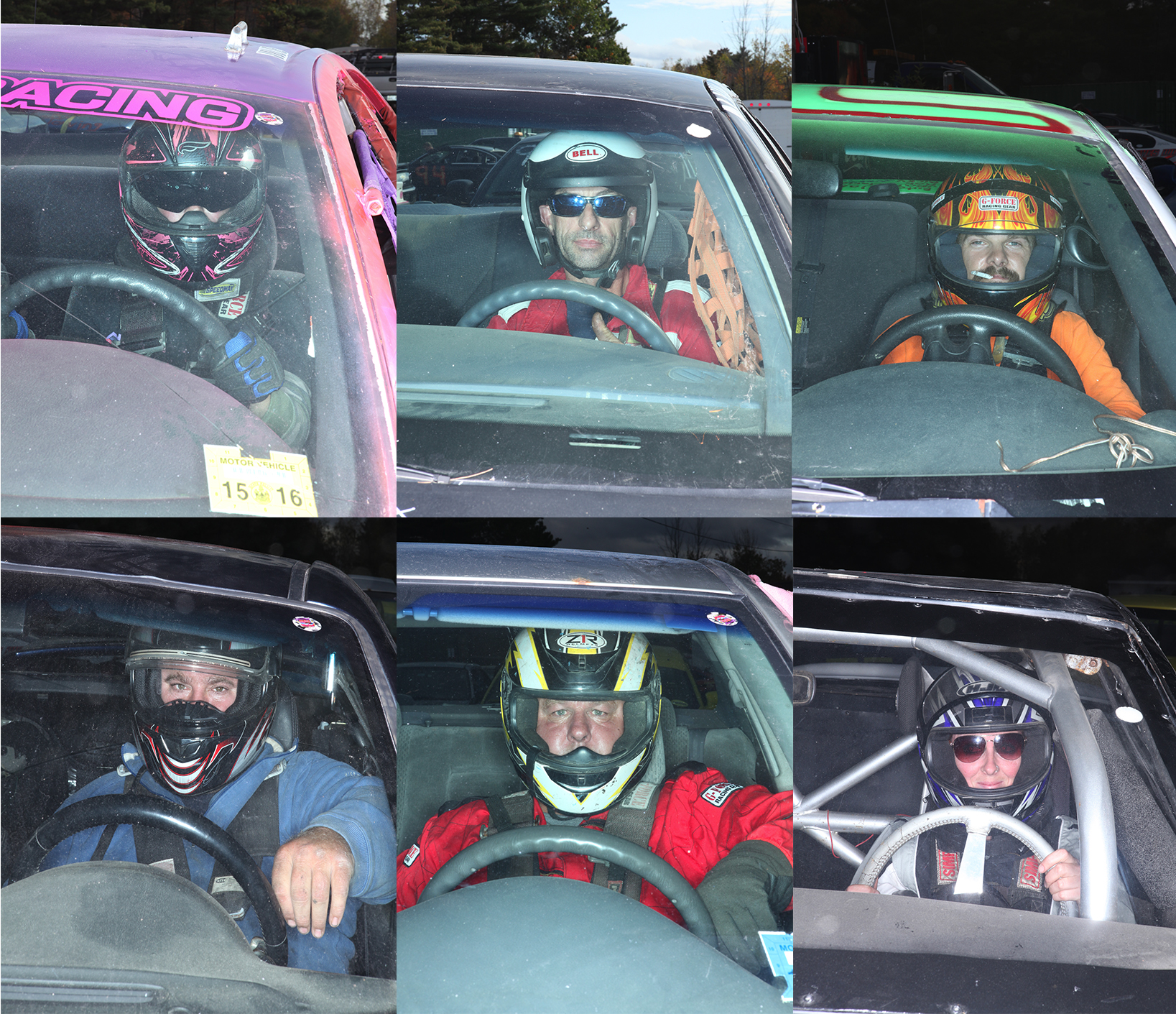
(Photo: Brent Humphreys/Pacific Standard)
Furthermore, Maine offered plenty of asphalt events, “hot top” in the local cant, which permit even minimally salvaged vehicles to achieve velocities that might result in a “big hit.” Indeed, it was just minutes after I began searching for a Maine derby to enter that I fixated on a single event: the three nights of hot-top demolition derbies at the 2016 Skowhegan State Fair, which, as it happens, claims to be the oldest continually running agricultural fair in the U.S.
Demolition derby in Maine, as far as I could tell, was neither particularly old nor continually running. The Skowhegan State Fair had seen its share of Hell Drivers, and I later uncovered evidence from the 1950s of a “Bomber division” at a raceway in Biddeford, Maine, but apart from that, the history of demolition derby in Maine was difficult to track. I heard rumors that an ongoing derby tradition had been interrupted by a death, and most folks agreed that derbies had been outlawed for a time, but started up again in the late ’80s. Skowhegan ran its first derby in 1992, years after the nationwide demolition derby craze had peaked.
III. THE WRECK AESTHETIC
Skowhegan sits just west of I-95, the only interstate that runs through Maine, and truth be told Maine got screwed by the Federal-Aid Highway Act of 1956, which created the interstate system and sliced the coast of Maine off from the rest of the state. Inland Maine is as rural as Wyoming or West Virginia, yet most people don’t think of this at all when they imagine the state’s rocky coasts and fishing villages and lighthouses and Bar Harbor. West of I-95 and for a few miles inland, Maine is all On Golden Pond country (the movie was set in Maine but filmed in New Hampshire), and a short ways further on it all becomes The Deer Hunter country, where neither electricity nor literacy is a given. As to Skowhegan itself, Benedict Arnold led an expedition through the town while he was still under George Washington’s command, the city was once a rallying point for temperance societies and abolitionists, and it was the home of Republican politician Margaret Chase Smith, the first woman to have been elected to both the House of Representatives and the Senate, once called “the most influential woman in the history of American politics.”
My first ride to Skowhegan was a slow easy drift past streets called Loon Road and Village Road and Old Mill Stream Road, and for a while there were nicely painted houses and perfect gardens and yards, but before long I was zipping past one-man taxidermist outfits, general stores, and businesses advertising live bait. More notably, paired with the well-groomed homes, there was an endless string of falling-down barns set picturesquely amid trees that had sprouted up all around them, sometimes inside them, and somehow these barns suggested that a particular kind of ruin had wedged itself into the local aesthetic—and this more than anything else explained why demolition derby had emerged and persisted here decades after the rest of us forgot all about it.
IV. AUTOMOTIVE ANARCHY
In Skowhegan, I met Corey Hight, one of a number of “Hight boys,” and his father, Walter Hight, who was said to be one of the richest men in Maine, though you wouldn’t know it from his baseball hat and the boyish slouch of his shoulders. The Hight family had come to local prominence with a now century-old automobile-sales business, and a couple generations back they had joined the governing board of the Skowhegan State Fair. Corey was in charge of Skowhegan’s demolition derbies.
I learned a lot in that initial chat. First, the popularity of demolition derby rises and falls with the price of junk. The Skowhegan derbies might attract 30 cars on the first night of the fair, 50 on the last, but a few years back, when China was paying top dollar for scrap steel, the number of derby entrants crashed. President Barack Obama’s Cash for Clunkers program had taken a toll as well. Corey explained that, in recent years, the idea of the perfect derby vehicle had completely changed. Used to be you wanted a big old rear-wheel drive tub, and clever mechanics knew how to kink the frame so that the car’s front and back ends bent upwards on collision. These days, however, what you wanted was one of those impossible-to-kill foreign jobs, front-wheel drive, and usually the winner was left with half a car, the vehicle pulling itself around the arena like a soldier who’s lost everything south of his spleen to a grenade attack.
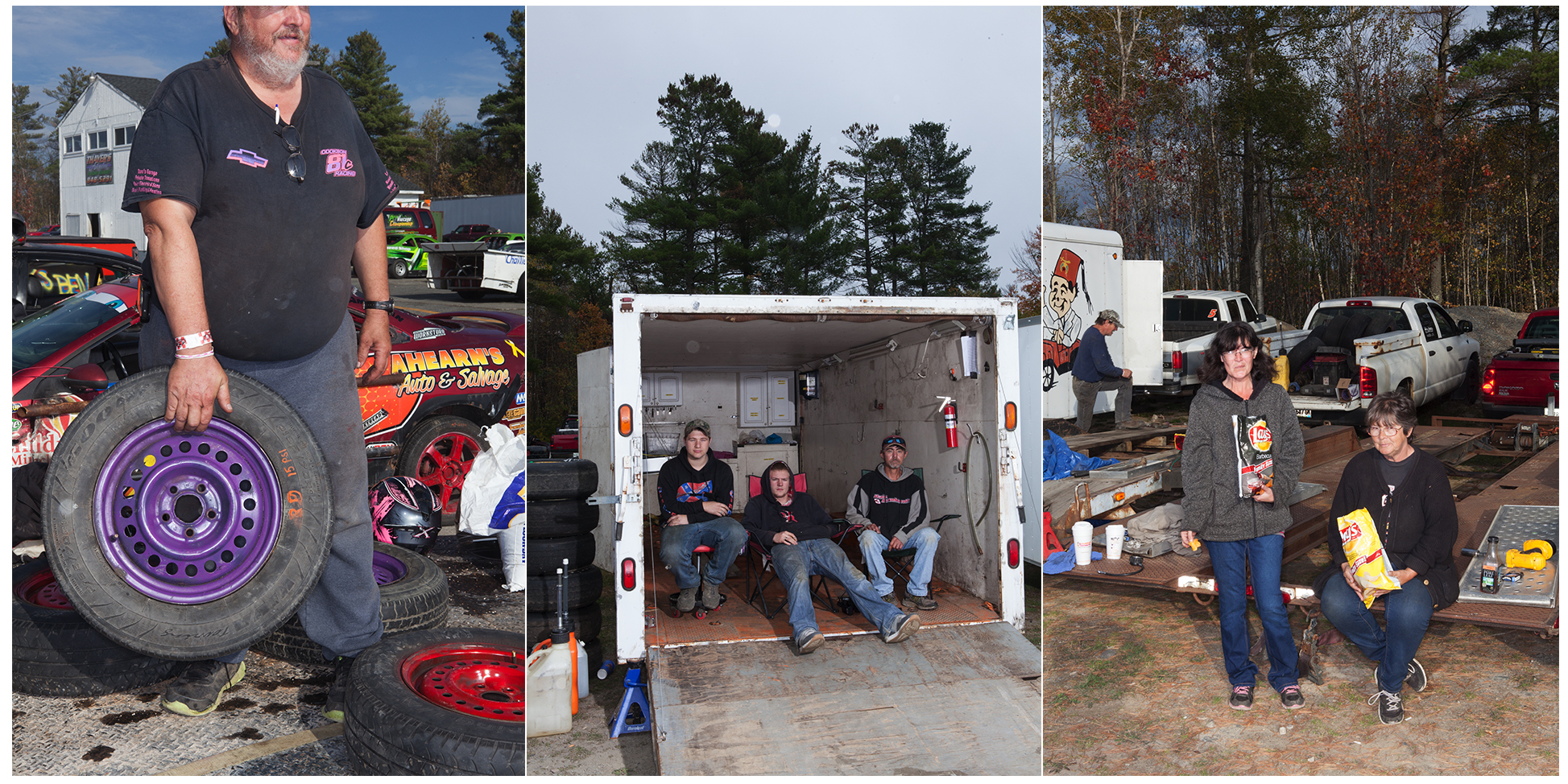
(Photo: Brent Humphreys/Pacific Standard)
Strategy had changed too, Corey said. Some drivers these days formed loose alliances with fellow drivers. They avoided unnecessarily dramatic hits in the early heats, saving the real action for the feature finale. Critics of this coordinated strategy, which tended to produce plodding battles of attrition, formed an opposing school of derby thought that regarded the event as a show and spectacle. This school measured the success of events not by cash prizes but by who registered the biggest hits, which might mean shoving a vehicle over the double row of Jersey barriers that formed the walls of the arena, or hitting someone so hard you set their car on fire. These two schools were each well-represented in the Maine derby community, exemplified in the first case by a crew of drivers led by Zach Audet, Paul Lyons, and Deuce Folsom, and in the second case by lone-wolf automotive anarchists—in particular one named Mike Gilbert.
“Oh, yeah—Mike Gilbert,” Corey explained. “Mike’ll give you a new perspective on everything.”
V. THE MALEFICENT GLEE OF SMASHING & RAMMING
Scholars have subjected demolition derby to a broad range of psychological and political science-based critical worryings. One academic wrote at length about the “hyperbolic masculinity” suggested by the “antiproductive event” of demolition derby, another claimed that “derbiers talk back to the political and economic forces” of their lives, and still another described derby drivers as “less powerful users of the automobile” who are attempting to invert their socio-economic status through the “destruction of this technology.” In no case, however, did a critic or ethnographer actually participate in a demolition derby. Even Tom Wolfe, writing about demolition derby for New York magazine, offered a description that was so routine—”the unmistakable tympany of automobiles colliding and cheap-gauge sheet metal buckling”—as to seem more likely the product of a borrowed memory than a firsthand experience.
I had a suspicion that one needed to get close, even to get behind the wheel, in order to fully grasp the appeal of demolition derby. This was confirmed a few days later when I drove back to Skowhegan to meet a few drivers. Zach Audet lived across the street from a graveyard, and the compound of his home—a perfectly middle-class house and detached garage with the number he runs, 19, affixed to the peak of the roof like a basketball hoop—seemed empty when I first arrived. I called out a hello, and got a response from deep inside the garage, where a car sat half in shadow like a slumbering dragon. Zach felt no pressing need to emerge and greet me. As a general rule, this part of Maine skips past all the superfluous crap of handshakes and farewells.
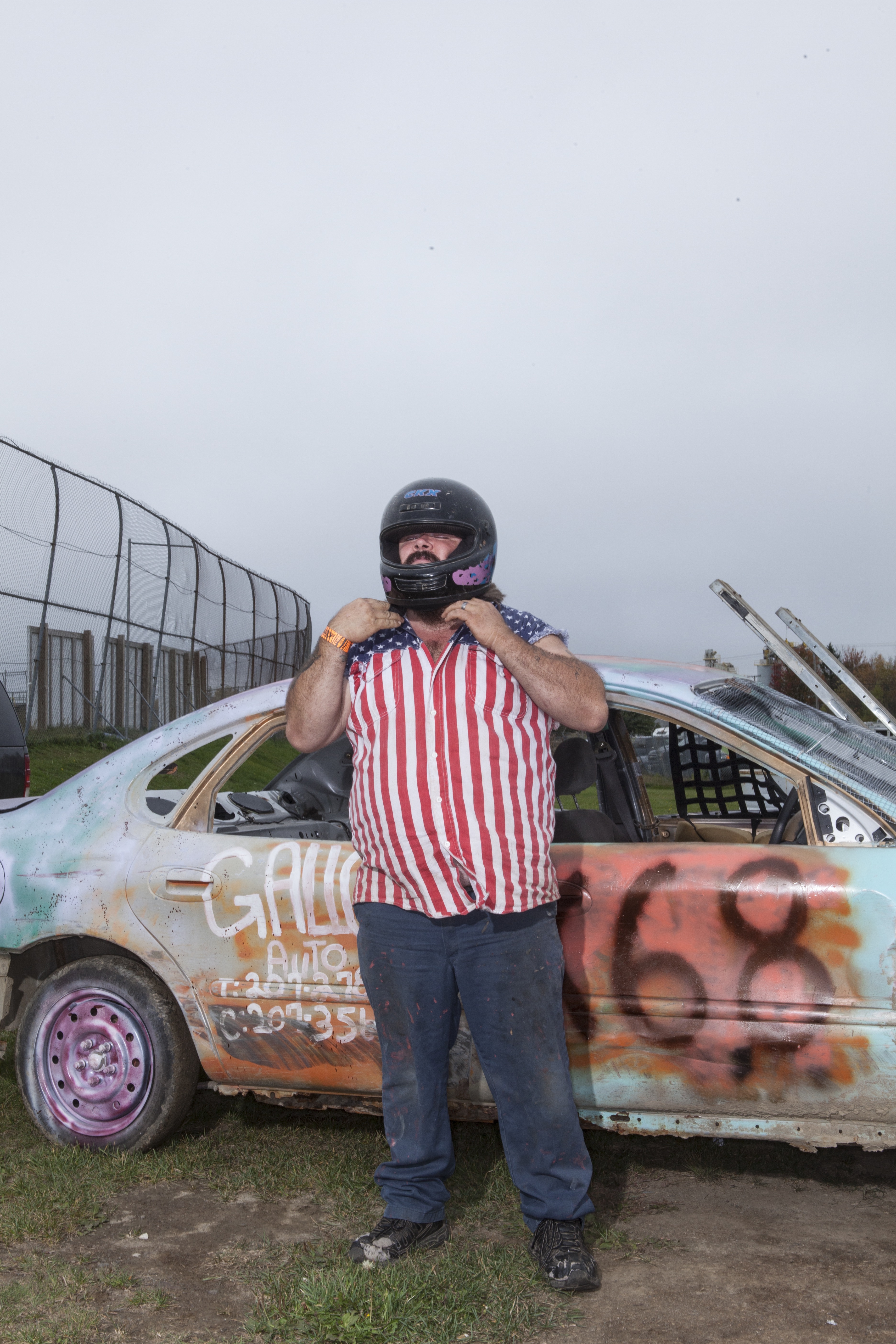
I moved further in, and it felt like advancing on the mouth of a cave where a bear might be hibernating. Audet was a compact man, less in the automotive sense than in the sense of a fist being the compact form of a hand. We chatted for a moment—though Maine’s not big on small talk either—and a few minutes later Audet’s teammate Paul Lyons arrived. Lyons was so large and cuddly compared to his partner that the two exhibited a kind of Laurel and Hardy, C-3PO and R2-D2 dynamic.
It was easier for Audet and Lyons to list the handful of derbies they had lost in the last few years than it was for them to fully document their recent domination of the Maine derby circuit. They admitted that if chance resulted in their respective cars being positioned directly across from each other at the start of a heat they would only tap one another as the flag came down, and then coordinate on the other vehicles. Some folks didn’t like that, sure. Lyons recalled that he had once heard rumors of a few disgruntled competitors drunkenly suggesting that they find his house and burn it down. But screw them: Lyons had three fused vertebrae to prove that he hit cars as hard as anyone. Anyway, teamwork was legal at Skowhegan, and if you didn’t like it, go drive Unity or North Portland.
Neither of them liked the plan I had cooked up for myself: to drive, when the time came, a late-model station wagon. Wagons tend to run hot, Audet said, and if you got one from Maine it would probably be rotted out on the bottom from road salt. They offered to help me build something more reliable, but I sensed the men tense when I declined, then revealed that I would be meeting Mike Gilbert in a couple of hours.
Gilbert had an auto shop and tow business and wreck yard a few miles east of Skowhegan in a small town called Canaan. He had Burl Ives’ benevolent slicked-hair-with-goatee look, and he had Ives’ same comfortable gyroid heft as well, which perhaps explained why he preferred larger derby vehicles, the “old iron” that was getting harder and harder to find these days. Gilbert’s A Plus Auto & Towing was on a road that connected deep inland Maine with the I-95 corridor. The only sign for his business was a badly crumpled derby car that had been hoisted up onto a boulder.
All of this took place in the portion of Maine that in recent years had come to be described as “purple.” Skowhegan is in the southern part of the state’s geographically dominant Second Congressional District, a seat once held by notable Republicans such as the already mentioned Margaret Chase Smith, President Bill Clinton’s Secretary of Defense William Cohen (once photographed at a demolition derby), and former Maine Senator Olympia Snowe. But a quarter-century ago, the Second District turned to Democrats, and both the district and the state had voted Democratic since 1988. In 2014, the seat flipped back to Republicans, though no one was sure whether it was a trend or a fluke as the winner had receiver fewer votes (133,320) than the losing Republican had received in 2012 (137,542). Mid-term turnout probably explained the aberration, but in 2016 there were rumors that Maine, which apportions its electoral votes by district, might go for Donald Trump, either in part or in whole, and by the time I was visiting Skowhegan, Trump had already begun smashing and ramming his way through the primaries with the kind of maleficent glee that makes demolition derby drivers feel right at home.
In fact, most of the drivers I met seemed like Trump people, and they were unafraid to wear their politics on their sleeves, or, as it turned out, on their cars. But Mike Gilbert, who while leading us to the rear of his junkyard bragged of being unafraid to tell Zach Audet that he was a sandbagger, he’d do it right here and right now, was a bit more difficult to pin down. A certain giddy fecklessness might have been what Corey Hight meant when he said that Gilbert had a unique perspective. This did serve him as a kind of camouflage; like an alien metal that confounds a compass needle frantically searching for Earth’s magnetic north, Gilbert bamboozled my own subtle probings to suss out anything resembling a political worldview. Or maybe he just lacked one. In any event, once we had trudged back behind the garage, out of public view and into a glen of wrecks stretching back into the Maine forest, Gilbert paused and looked up to consider a small mountain of demolition derby vehicles that he had accumulated over the last few years. There were wrecked derby cars all over the place. Ostensibly, Gilbert was waiting for the price of junk to go back up again and then he’d haul them all away, but in that moment he looked up at the oddly well-composed mound of color and rotten metal as Jeff Koons might admire one of his own sculptures.
“It’s like a male ego thing,” Gilbert said, back in his crowded office, taking a crack at the basic riddle of demolition derby. “It’s like a bar fight where a coupla guys will just say, ‘Let’s do it—let’s do this thing.’ Or it’s, you know, like Vikings out there having a war or battle or whatever.”
VI. THE TURN IN THE BATTLE
Automobiles were once the bane of the recycling movement. In 1969, 70,000 cars were abandoned in New York City alone, and, the following year, the Institute of Scrap Iron and Steel—which, thank god, there is one—convened to decide what to do about it. The giant metal-shredding machine came into widespread use not long after. Journalist Adam Minter called it “the singularly most important piece of recycling equipment ever made,” and the American automobile is now one of the world’s most recycled products.
I don’t think it’s an accident that the popularity of demolition derby peaked precisely at the moment when junk cars were recognized to be a significant problem.
Like the maiden-mother-crone life sequence of witches, the men of demolition derby break down into three categories. First, there are the drivers themselves, men between 16 and 30, often of a lewd, diabolical handsomeness. These are men who work at auto-parts shops, or at wreck yards, or they have just started running their own garage, and among them is observed a strict code of anti-fashion: black jeans, black T-shirt, baseball cap, black sunglasses. Substitute camouflage for any single portion of this ensemble. When I moved to Maine I was anxious to resolve a mystery that had long troubled me: How had the benign grandfatherly stereotype that I associated with its men, the gentle fishers of lobster, the harmless makers of maple syrup, produced the downhill bayonet charge of the 20th Maine Volunteer Infantry Regiment at Gettysburg, a suicidal tactic that helped save the Union left flank, perhaps turning the tide in a pivotal battle of the war? Maine derby drivers, full of quiet, seductive menace, were descendants of those badass patriots, and what you could sense in them at a glance was a recklessness that in the right context is counted as courage and perhaps once saved the Republic.
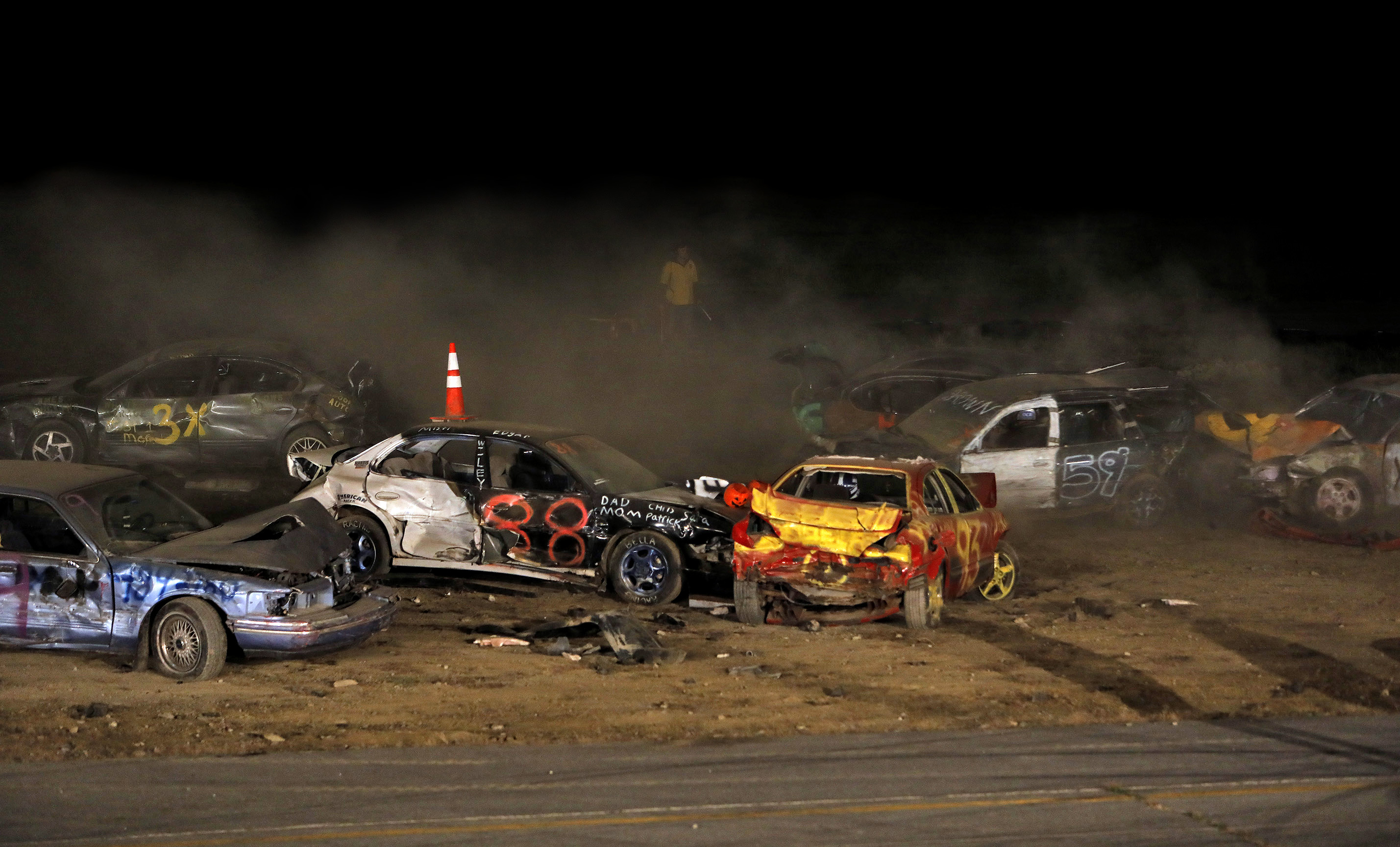
Next are the former drivers, men like Mike Gilbert who had put on pounds as well as miles, and had stopped shaving some time back, though they might occasionally take a clipper to their whiskers. These men consider themselves retired from what is thought of as a young man’s game, but they might still drive derbies from time to time, much like high school quarterbacks who nurse their wrecked knees and speak wistfully of the glory days, but will take a few snaps in the backyard if you goad them enough and there are ladies watching. They have largely made the transition from player to coach and commentator (Gilbert has a son, Mike Jr., also a driver), and in the pit between heats they offer polite wisdom from a distance as crews struggle to replace radiators before the feature.
Last are the old-timers, who are not necessarily old, though the complete abandonment of the curation of facial hair has conferred upon them a hermit’s mien, landing them in a fashion niche equidistant from Mr. Natural, Walt Whitman, and sasquatch. Old-timers show up unannounced, hang around the garage in the daytime, bring their own beer or drink yours, and still have a pretty good sense of who to call for obsolete parts on Sunday afternoons. Hirsute and quiet, they remain stoic observers, content as adjutants to the action and community of demolition derby, like eunuchs loyal to the queen.
I would come to rely on all three once I decided to purchase the sky blue 1965 AMC Classic Rambler station wagon that had sat in Mike Gilbert’s yard for several years. He’d bought it off a guy named Sputnik.
VII. A POCKETFUL OF MOTHERFUCKING NUTS
Gilbert didn’t want to sell me the Rambler—even though his own first derby vehicle had been a ’71 nine-passenger wagon. He said that if I wanted to run rear-wheel drive I should get my hands on a Chevy Lumina. Maybe a Lincoln. But really the problem was that the Rambler had aged into status. At this point it was a classic, and he believed that someone would eventually come along with the perfect combination of automotive skill and whimsy required to restore the old lady to her glory. I had to make him an offer he couldn’t refuse ($500).
Furthermore, after an extended period of waffling between Maine’s two derby philosophies, I threw in with the lone wolves and enlisted the help of the uncle-nephew team Rick and Ethan Lyons to help me build the Rambler.
Ethan was a young driver, of a slightly sweeter disposition than the usual rogues’ gallery of demolition derby. He’d driven his first event just four years earlier, running a two-door ’99 Pontiac Grand-Am that got shoved up onto the barriers and caught on fire. Before he knew it, the whole right side of the car was up in flames. Ethan jumped out, broke his leg. No big deal. Now he was running five or six cars per season. I liked Ethan because even though casual misogyny was an undeniable feature of the derby world—a nut that refused to loosen could be aptly described as a son of a whore or, worse, a motherfucking cunt—Ethan had once built and driven a demolition derby car themed on breast cancer awareness. It was painted pink front to back, ornamented with ribbons and slogans: “Save ’em all, big and small.” Ethan was young enough to be my son, but he had a timeless personality, and when he explained strategy to me—aim for the axles of other cars, drive in reverse ’til the rear end bends up and you can’t see anymore—he fell naturally into the detached bemusement of a camp counselor teaching a nine-year-old how to steer a soap-box derby car.
Ethan’s Uncle Rick had always been a car guy, but health concerns had slowed him down a bit, and now he stuck to showing horses, pitting for his nephew, and operating Rick’s Pit Stop in Skowhegan. Rick actually ran two small businesses, a trophy shop and the garage, all of it more or less attached to his house, such that what Rick really had was a sprawling, multi-room man cave, the kind of masculine escape that suburban dads and executives dream about while their wives drag them to rom-coms or the opera. Rick was a kind of genius, and I think he liked the idea of me running the Rambler because it hailed from the era when everything in a car was still mechanical, not all this shit-ass computer hoo-ha that was on the brink of rendering a mechanic like him obsolete. Plus, a 51-year-old engine posed a tantalizing challenge to any mechanic’s resourcefulness and wits.
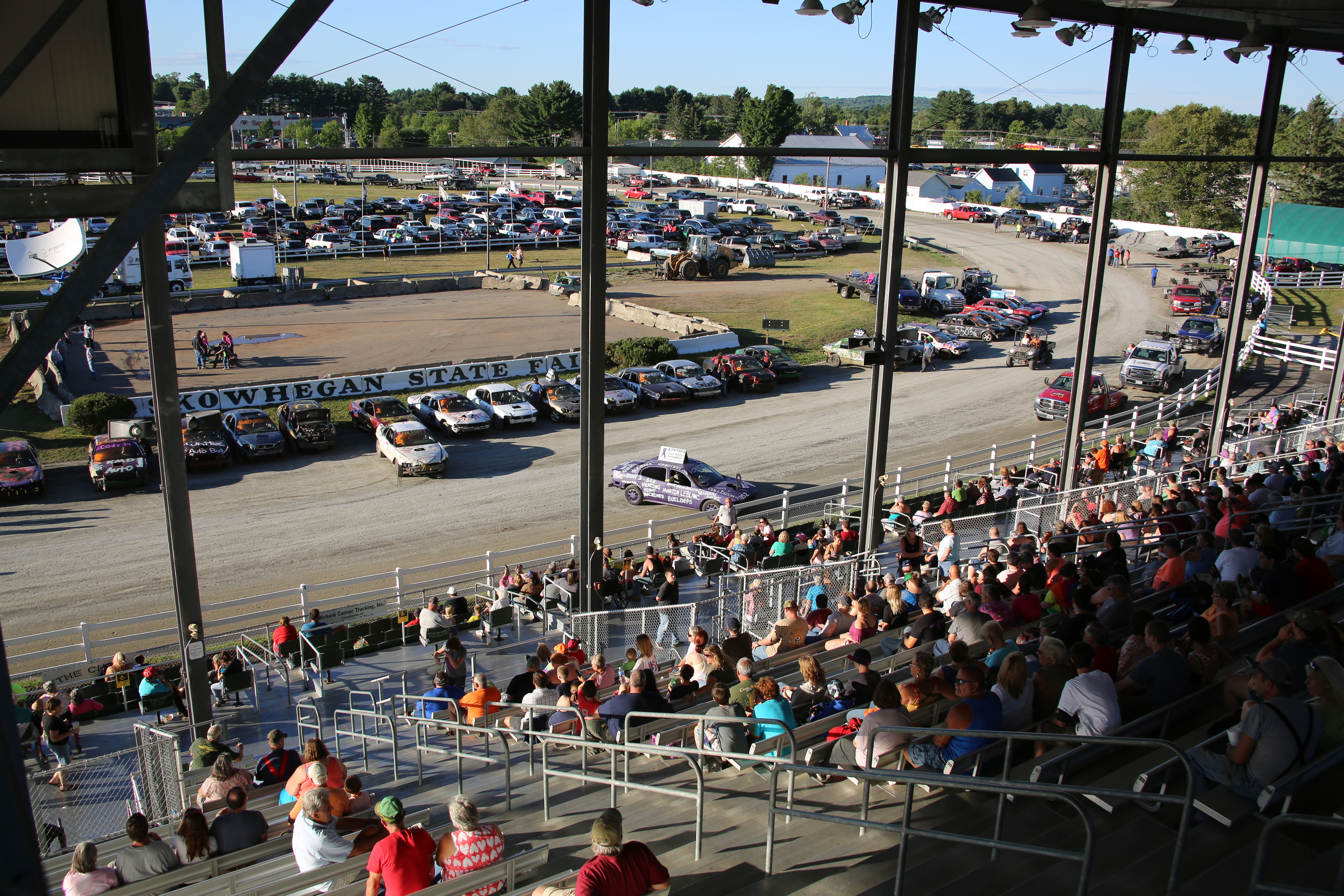
(Photo: J.C. Hallman)
Before we took the Rambler to the Pit Stop, though, I worked an afternoon on the car with Gilbert and a man named Guy Stevens, who might have been anywhere from 45 to 70. Guy wore a beard that grew with an ivy’s sense of insistent agency, and he seemed to prefer communication on the level of the vowel sound to that of the word. I picture Guy now as I saw him on derby nights, hanging off the back of Gilbert’s wrecker. Gilbert’s was one of four wreckers who yanked dead cars out of the arena between heats, and Guy rode on the back to attach chains to the cars. He remained placid throughout, his beard long enough to bend 90 degrees in the wind as Gilbert gunned the engine to hurry disabled vehicles back to their pit crews. Riding past the bandstand was a kind of fame for everyone—drivers would often perch on top of their cars, smiling and waving to the crowd—but if Guy took any joy in his moment at the center of attention he didn’t show it, clinging to the back of Gilbert’s wrecker with an air of duty worthy of a Buckingham Palace sentry.
The demolition part of demolition derby begins long before you drive into the arena. A good rule of thumb to follow as you prepare your vehicle is that everything in a car that might become a projectile will do exactly that. Prudence and the rules require the removal of anything plastic, and anything attached to the car with screws that would break with the same limited force it would take to snap your pinkie finger. Guy and I dove in on the Rambler, and I thought I was being pretty aggressive, tearing away strips of rubber and amassing a pocketful of motherfucking nuts that I practically had to dislocate my shoulder to loosen. But then Gilbert stepped in and ripped out the Rambler’s rear seat in one great ursine chomp. Guy hauled away windows, and together we pried at the plastic holding the windscreen in place, until by mistake we cracked the 50-year-old glass. No matter. In a few hours, we had undone much of the work of what had probably been a hundred-man assembly line, the initial labor most likely completed in a Kenosha, Wisconsin, plant where cars had been under construction since at least 1902. The last engine was built in the Kenosha plant in 2010, and then, as we were doing with the Rambler, the building was demolished in 2012.
A few weeks later, Gilbert hauled the Rambler over to Rick’s Pit Stop and we tried to start it for the first time, feeding gas over the carburetor’s floppy throttle valve. The Rambler rumbled to life, belting out an impressive snarl after 10,000 nights of crickets and dew. We pushed her into the garage, elevated her, and drove a bolt into the gas tank to let decades-old fuel drip into a pan.
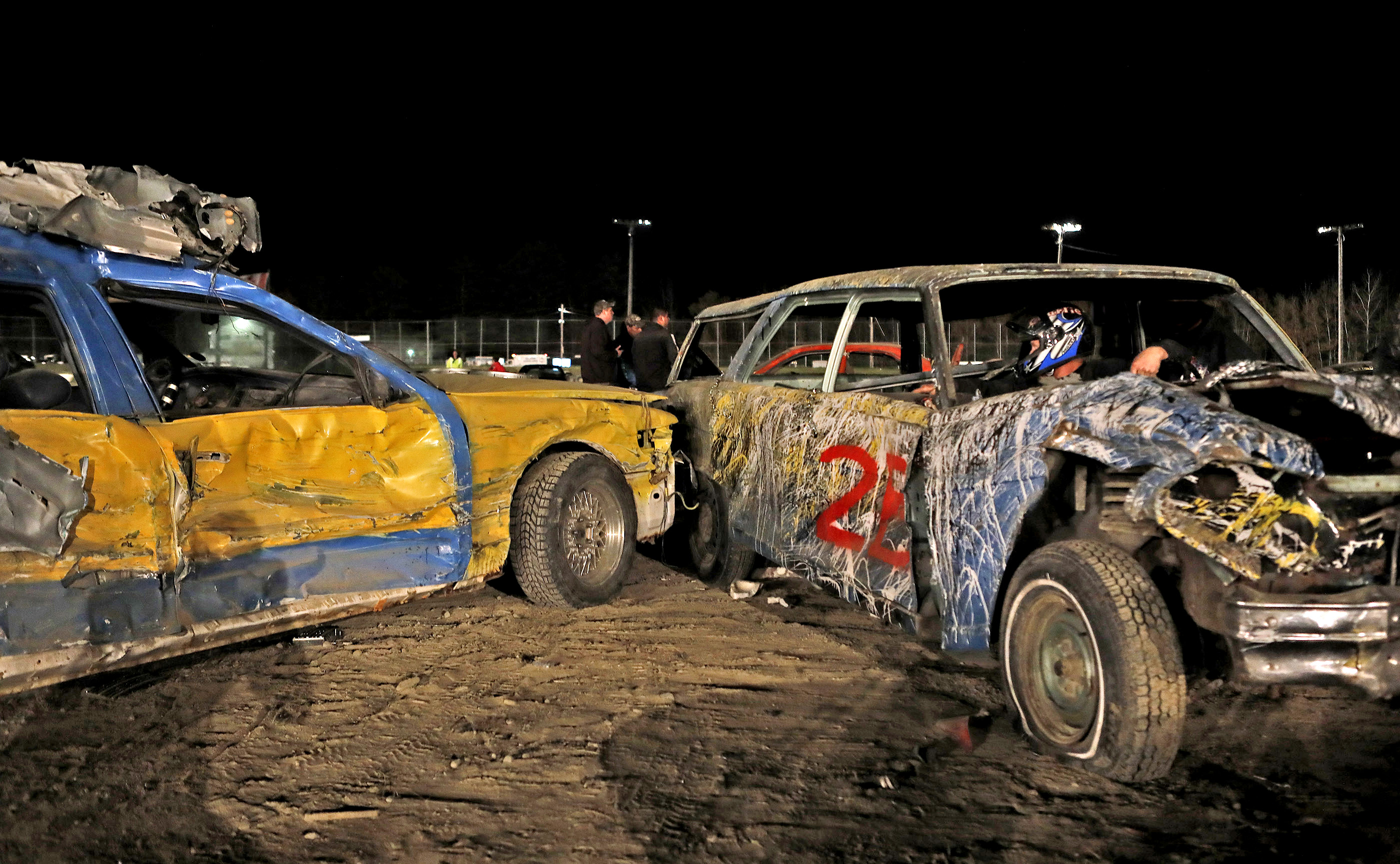
From there, Rick took over on the engine, and Ethan set to the tasks of moving the battery (to the passenger seat) and the gas tank (behind the passenger seat). For the first couple of hours Rick went into a deep think on the master cylinder. The part came out of the car easily enough, but the rest was a real bitch of a job, to put it politely, and it turned out that the master cylinder, about the size and weight of a Fort Knox-style gold bar, depended almost entirely on viscous brake fluid flowing through a hole so small you’d have a hard time penetrating it with fishing line. In the meantime, I got to paint the driver’s side door white so that other drivers would at least have a chance of spotting me before barreling into the one spot on a car you’re technically not allowed to hit (though it happens all the time). When I finished the third coat, Ethan pulled out some kind of percussive saw to cut a diamond-shaped hole in the hood so that flames would have a place to go if the Rambler lit up. This device sent rooster tails of sparks sailing through a room where almost everything appeared coated, to my untrained eye, with either oil or gasoline. Ethan did not wear goggles for this job.
Gilbert occasionally stopped by to see how the work was coming, and so did several others, and Rick eventually had to give up on the master cylinder (and the starter and the fuel pump too), and that meant the afternoon was eaten up by a lot of phone time, guys talking to other guys all over Maine about the ’65 AMC Classic Rambler that some idiot intended to destroy in a demolition derby. Almost always someone knew someone who knew someone else who rebuilt master cylinders just for the fun of it. Originally, Rick and Ethan had agreed to perform this labor out of the goodness of their hearts—i.e., for the cost of the parts they’d salvage once the Rambler had been demolished—but before long the goodness in Rick’s heart began to run low, and when he was running on goodness fumes alone I agreed to fork over several hundred dollars more. The Rambler was hogging his sole lift. He was losing business.
I returned two weeks later with a Lithuanian artist, who in an hour transformed the Rambler from a stripped-down symbol of tepid mid-century American dream to a squiggly Pollock fever nightmare. Just before the start of the fair I painted the numbers on the doors; one side read 2B and the other not 2B—the second “2B” in a circle with a slash through it.
VIII. A MESSAGE TO ETERNITY
The first sign of trouble came on the day the fair opened. The Rambler wouldn’t hold an idle. I met Rick and Ethan and Gilbert out at Gilbert’s property, and we each took turns running 2B or not 2B up and down a lane in the forest. It could get up to about 30 mph—run like a “raped ape,” as Ethan put it—but if the car wasn’t hot enough it sputtered and stalled. Alternately, when the engine got too hot, puffs of a sulfuric pit-of-hell smoke belched out the hood’s diamond-shaped hole, threatening an engine seizure.
There wasn’t time to make further adjustments, because Ethan had to get his own cars over to the fairgrounds. Fortunately, I wouldn’t be driving until the last derby night.
On that first evening I realized that the “pit” in Skowhegan was more metaphor than place. The derby arena was positioned in front of a bandstand, on the far side of a harness-racing track—thinly attended races were held on non-derby days—and just as the afternoon light eased to a cool slant, derby crews began to trickle in and set up temporary shops along the outer rail of the track. For the duration of the evening, the dirt horse track was the pit. Zach Audet was among the earliest to show up, and he secured a spot close to the derby arena itself, sectioning off an area not just for a single car, but for multiple vehicles run by himself, Paul Lyons, Deuce Folsom, and several others from their team.
As a serious crowd streamed in and derby cars completed a colorful chain stretching the length of the track, it all had the feeling of a battlefield’s staging area. Strutting up and down his row of vehicles, with signs for the tire shop where he worked affixed to their roofs like menacing shark fins, Audet shifted between impersonations of George C. Scott’s Generals Patton and Buck Turgidson, exuding hyper and hyperbolic macho in alternation. A few weeks before, I had driven up to Bangor’s Speedway 95 to see Audet compete in a mini-stock race. From the moment the flag fell, there was something sociopathic about his driving. It wasn’t that his car was faster. It was that he was somehow meaner, his experience in demolition derby seeming to have smothered his capacity for empathy. The other drivers got out of the way, or they risked the hospital. Now, Audet was among the first drivers to pull his vehicles into the arena to be tech’d: to pluck a numbered golf ball from a bucket to determine the heat in which his car would be placed, to sign a waiver, and to subject his vehicle to judges who examined the frame, doors, and tires of each entry.
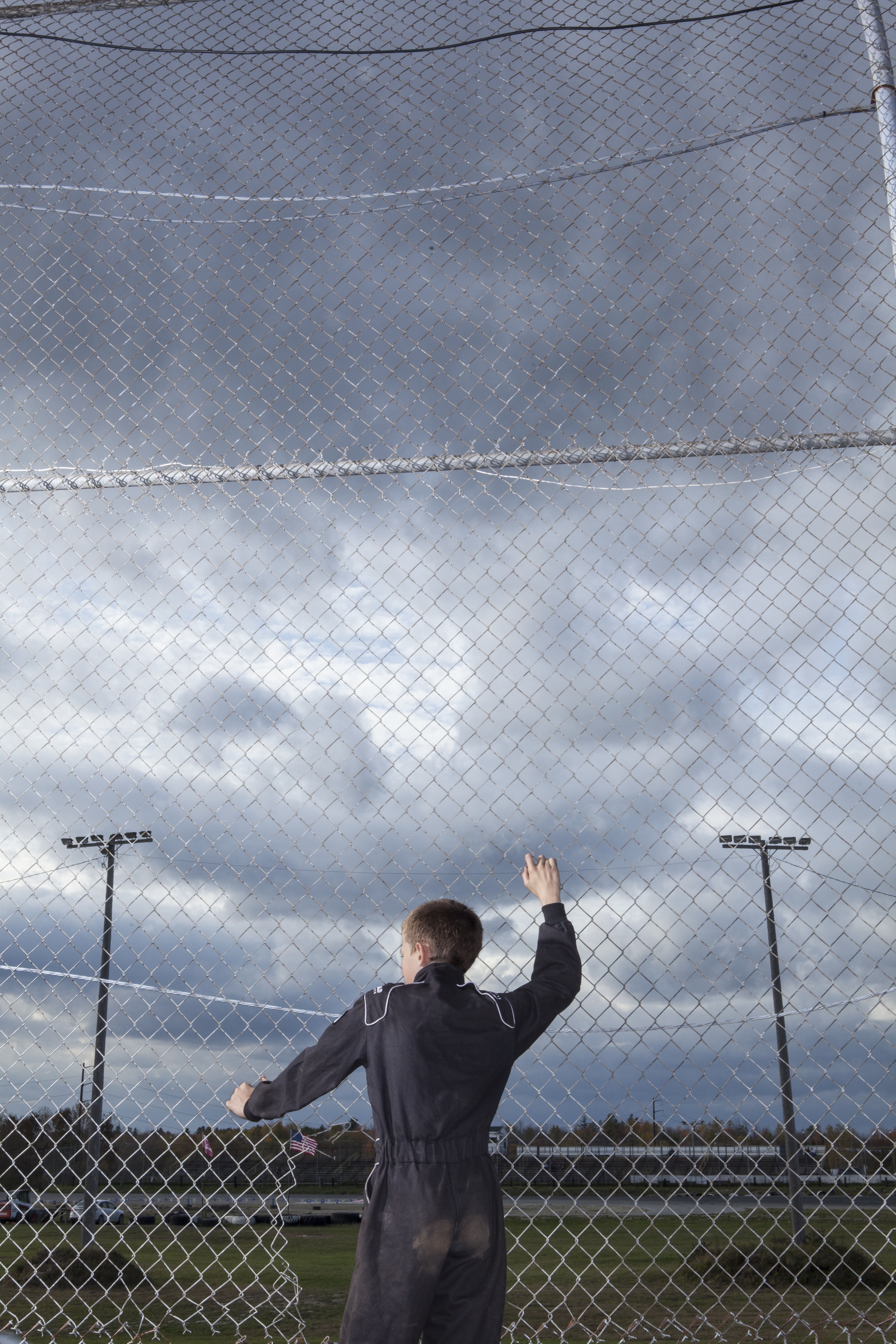
After being cleared, the cars lined up on the track as though preparing for a parade, and during the hour or so it took for the entire process to be completed it was possible to walk out into the pit to examine the vehicles that had been approved for competition, and many did, teenaged girls wandering in pairs to flirt with the drivers, and young mothers pushing strollers over the loose dirt. The cars were painted garishly, and up close you could see that some vehicles, as with Ethan’s pink Lincoln, had been decorated to increase awareness of diseases that disproportionately affect rural communities. Other cars were festooned with the names of the dead, loved ones lost since the last derby season to old age or overdoses, the messages scrawled so small on the body of the cars it was clear they were not addressed to the crowd, but to eternity.
The evening proceeded with the average state fair’s imported urban milieu, and early on folks exhibited a kind of ironic indifference that I’m tempted to label “hickster”: They spent more time recording the scene on their smartphones than taking it in. The mood changed the moment the announcer kicked in from the overhead press box with the volume turned so loud—to be heard over the roaring engines—as to seem like the voice of a jealous god or his minion on Earth. The fact that fair officials had not splurged on some local beauty-pageant diva to belt out the National Anthem, but instead left the task to this same announcer, was the first sign that derby night was going to exhibit an inimitable authenticity. Folks stood, removed their sweaty hats, mumbled out what lyrics they remembered, and thought about loved ones, sick ones, and the ones fightin’ over there in Arabia.
Well past the moment when the first 16 cars pulled into the arena—the night’s turnout was a surprising 57 vehicles, spread over four heats—I sustained a belief that the actual clash of a derby would exhibit a clear beginning, middle, and end, and that this would easily translate into story. Like a baseball scout, I kept careful track of who won each heat, and predictably the winners were often members of Audet’s circle, Audet himself scoring the first win with an effortless precision. Ethan ran two cars on the first evening, and Gilbert’s boy ran a car that first night as well, and even though they didn’t win they were pleased with their performances. In the second heat, Ethan stormed out of his starting position and ploughed into the car across from him before it had moved even two feet. It never moved again. He logged several more big hits before someone illegally hit his driver’s side door, and he was left slamming his steering wheel in frustration. On the second night, Ethan’s evening came to an end when he backed into someone so hard he drove partially on top of them. He was running rear-wheel drive that night, and was left with a still-viable vehicle that couldn’t move because its rear tires weren’t touching the ground.
It’s easy enough to describe what happens in a demolition derby, and each of the accounts I’d read had found a new way to say that a bunch of cars run into each other, and it’s loud. But that doesn’t really do it justice. There is no single storyline to demolition derby. Unlike a football game, there is no ground to take, no points to score. There is only mayhem and survival. I’d been on the right track in asking my Lithuanian artist friend to paint up the Rambler like a Pollock drip dream, but the truth was that demolition derby did not so much remind one of Jackson Pollock, as reveal the chaos that Pollock had attempted to capture on canvas. And for what it’s worth, the first night of demolition derby at the 2016 Skowhegan State Fair fell on the 60th anniversary, plus one day, of the death of Jackson Pollock. He was reportedly decapitated in an automobile accident on Long Island.
IX. THE AWFUL STILLNESS OF SPECTACLE
Halfway through the first night I wandered down through the pits and watched a heat from the back of a flatbed tow truck where a small party was underway. Someone helped me up and handed me a beer, and people chatted and drank until the next heat’s cars rolled in and a bulldozer shoved the cement barriers back into place, completing the arena’s rectangle. From here, the colorful quilt of the bandstand crowd, numbering upwards of 8,000 people, loomed behind the derby cars, and what this vantage revealed, when the announcer completed the countdown and the growling, vibrating cars launched into their mad scrum, was that the frenzy of the event was entirely limited to the derby arena. The crowd, both in the stands and around me, was, for a moment, awed into a reverent stillness—no smartphones, no cheering—and if not for the engine noise, it might have seemed like the instant of shocked stillness that tends to follow acts of wanton cruelty. I have to believe that a similar kind of caesura followed the tragic moments in which vehicles were recently employed as weapons in Paris, Barcelona, London, and Charlottesville.
Later, when I was standing in a thin crowd near the emergency fire truck, an overlooked piece of loose metal came flying off a derby car, winging and whistling through the air at the spectators, and only a short corrugated-tin fence prevented it from amputating someone at the knee. Folks oohed as if in response to a striking firework.
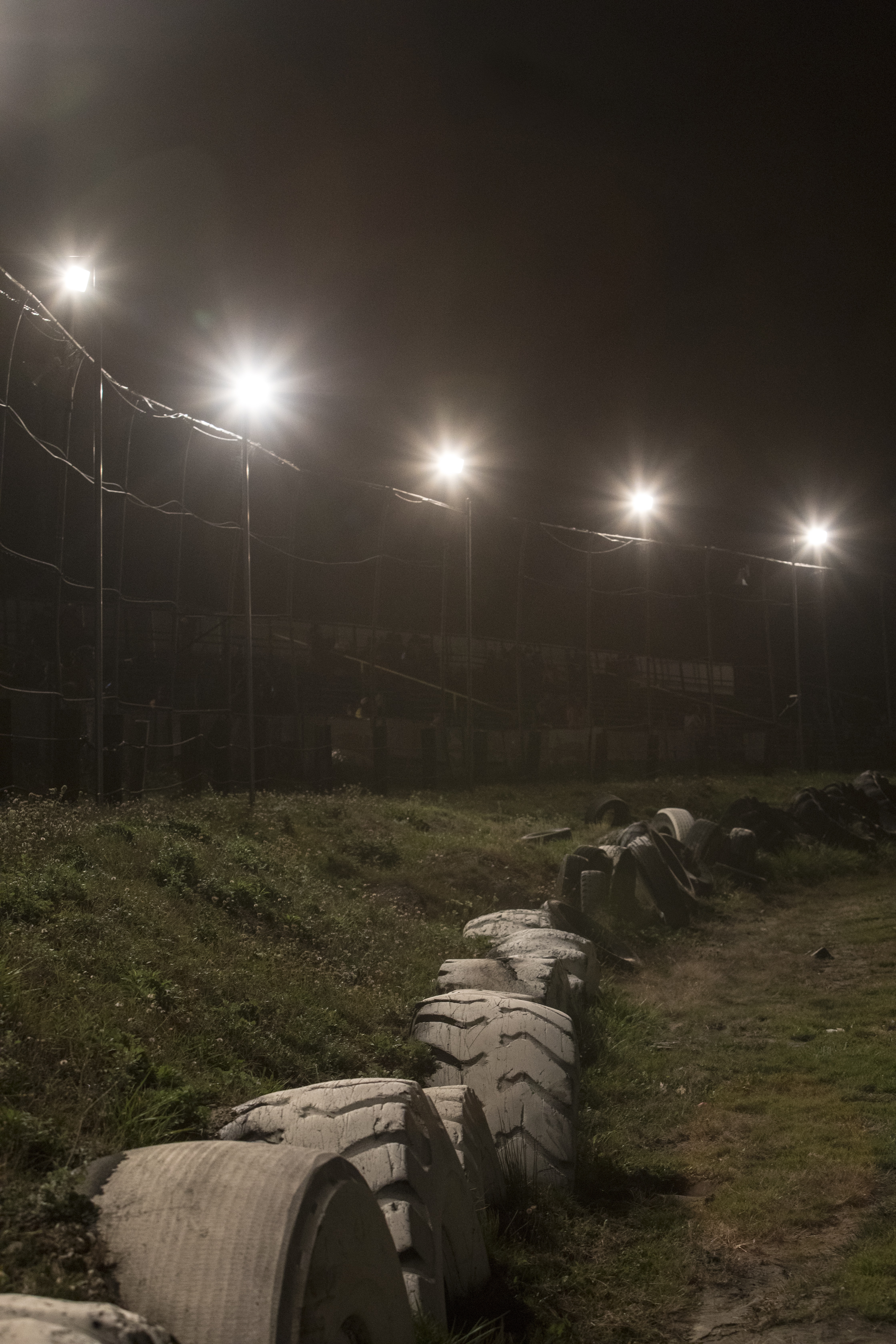
It wasn’t until the morning of the final derby night that my nugget of fear finally reappeared. We’d done some more work on the Rambler in the interim, replacing the battery cables because the added distance of running power from the front seat drained the charge, but we didn’t bother with any of the ingenious tricks that derby mechanics had devised over the decades: pepper in the radiator to plug leaks, or running on jet fuel because it burns cooler. It wouldn’t matter. The second sign of trouble for the Rambler was that the adapted gear shifter we had devised, made from a long metal dowel rod that shot up through the floor of the car, was loose by design, yet just about everyone who tried driving the Rambler had difficulty distinguishing drive, neutral, and reverse. It was the kind of thing you’d need to get the feel of, but how could you get the feel of it when you couldn’t legally drive it except while attempting to smash it into other cars?
Gilbert and I made a few last-minute adjustments to the Rambler, including trying on trailer tires that didn’t fit. Then we pulled 2B or not 2B up onto his flatbed and rode over to the fairgrounds, where an unexpected traffic jam of derby cars had been lined up for a couple of hours already. Gilbert left me and the Rambler alone on the final furlong of the track, at the spot where, as the horses stream past, the announcer tends to scream, “And down the stretch they come!”
X. THE HILLARY VOTER
I walked among the multiplying derby crews. Once the gas-powered generators had been fired up, once the crews got their cars running on-site and completed final adjustments—sometimes with tiny screwdrivers, sometimes with sledgehammers—there wasn’t much left to do but chat with their families and make an effort to exude Gilbert’s let’s-do-this-thing vibe. For the most part, folks were happy to talk with a guy who wore no baseball hat and no camouflage, and was that a notebook? But when I approached a crew from a local auto-body shop preparing two black vehicles, a young man who was putting the finishing decorations on one of the cars—Trump in masking tape—eyed me up and down and announced, “You’re a Hillary voter, ain’t ya?”
He was perhaps 21 and so baby-faced it was more accurate to say that he resembled his infant son, nearby in the arms of his young wife, than the other way around. He had two kids, I think, plus the wife, plus the small business, plus the leisure time and excess cash to front a derby vehicle for himself and another for a friend who was even younger than he was. Here was another side to the demolition derby story: conspicuous consumption, the blithe destruction of vehicles becoming a way of announcing that you’d made it, that you were living the dream. Truth be told, I’ve always admired people like this guy, folks who took their shot when they were young, found their mate, and thrived, and I suppose it impressed me because it took a kind of economic focus and chutzpah that I lacked entirely. In any event, he was spot on about my vote, but I hedged in responding. He wasn’t the only derbier trumpeting Trump with his vehicle that night, and soon enough Maine’s Second Congressional District would, in fact, vote for Trump by a huge margin. 2014 wasn’t a fluke. In 2016, the Second District’s Republican representative won re-election with more votes (192,878) than any Republican had ever received in Maine. Trump reversed a 24-year Democratic trend in the district. For a time, on election night, when results from Wisconsin, Michigan, and Pennsylvania remained uncertain, pundits speculated in all seriousness whether the dramatic reversal of Maine’s Second District would produce the single electoral-college vote that would swing the entire election.
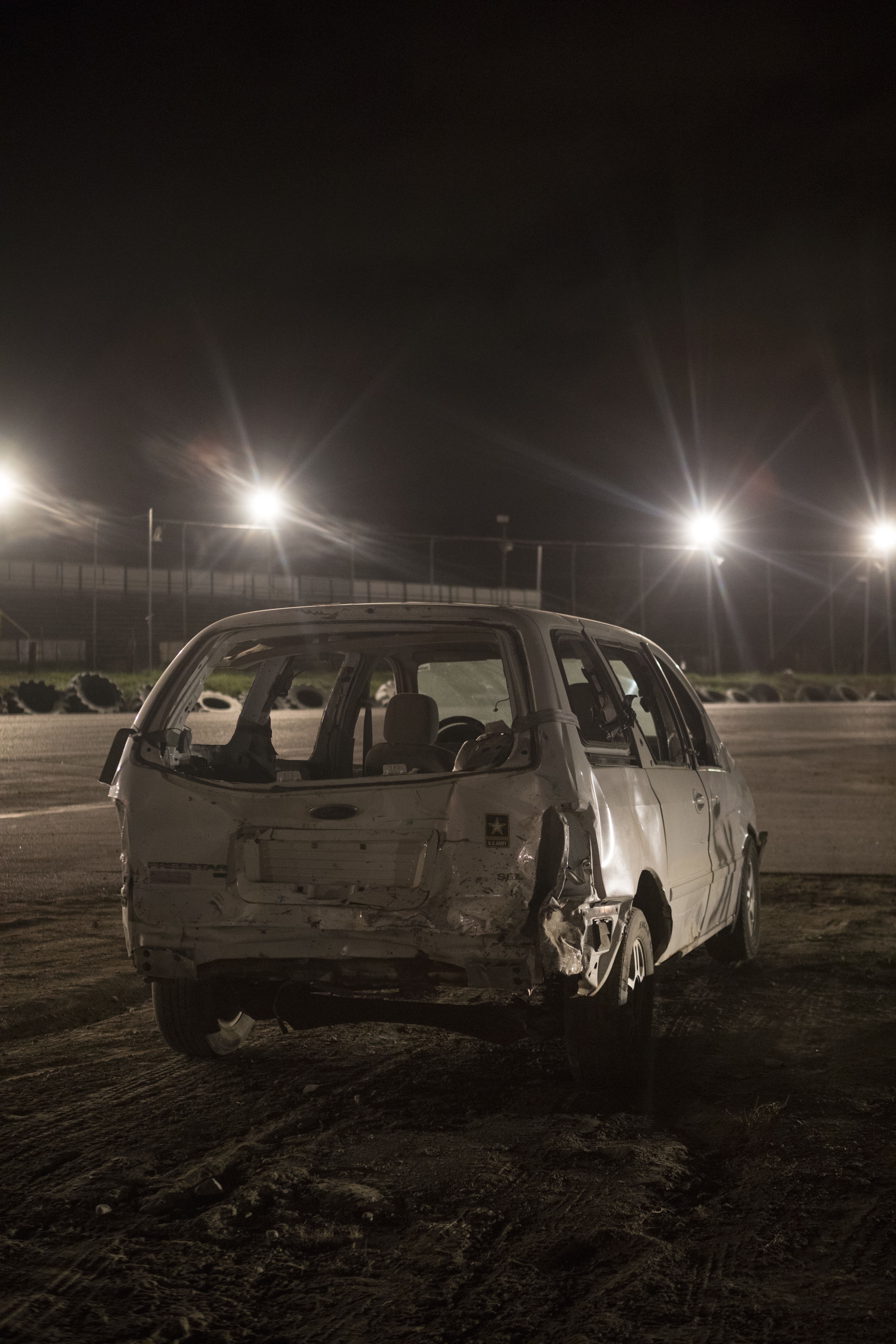
I admit to being baffled by this. For what is an auto mechanic but a technician who has spent a lifetime accumulating wonky knowledge that is arcane and tedious to others, but which is essential to the operation of a system, in this case a car, of which most of us only blindly partake? When something goes wrong with that system, vehicle owners do not return to the salesman who sold them the car. They consult a specialist with years of experience who can give them the bad news of what went wrong, and how much it will cost to fix it. The salesman had needed to know nothing at all about the vehicle in order to sell it. That job is all bluster, hyperbole, and hucksterism. True, Trump delivered any number of “big hits” through the primaries, crumpling careers and scorching political legacies. And his subsequent presidency offers a perfect demonstration of the fact that, in both politics and demolition derby, all victories are Pyrrhic, because even the winner drives away in a wreck. The confusing part is that the 2016 general election wasn’t anything at all like a demolition derby. Rather, it was a choice between an auto mechanic and a car salesman, and the actual mechanics of the world let themselves get sold a bad lease on crap car by an ugly guy in a cheap suit.
“It is what it is,” said Ethan, upon arriving at the fairgrounds after failing to make ready a car called The Hulk that he’d hoped to enter at the last minute. “Now I just want to hit something.”
The final derby night exceeded all expectations: 93 cars had entered. The pit comprised the entire loop of the racing track, both the inner and outer rails. No one could remember anything like it. The tech process took almost two hours to complete, and approved cars had to double-park in front of the bandstand. Vehicles would cram into the arena 20 at a time for five preliminary heats, and there would be one consolation heat for any eliminated cars that could be got running again. The final round, the feature, would determine the night’s winners. This, of course, would prove to be Zach Audet. Long after dark, Audet wound up in a protracted duel with a driver all the way from New Hampshire. The final scene of the evening whittled its way down to an apocalyptic atmosphere, the two cars limping among the dead, dark wrecks, spraying sparks as their wheel rims gouged at the hot top. The scene was actually lit by flames because the oil pan of one vehicle had been punctured and caught a spark, and when the fire crew sent in streams of water to douse the blaze it only grew taller. They let the two men drive by firelight until Audet, by dint of his car’s ability to creep forward slightly faster than his opponent’s, was declared the winner.
My own best showing was in the consolation heat, when more than 26 vehicles crammed into the arena and the countdown fell on what started, just as I’d hoped, like a rush-hour traffic jam. I hit a couple of cars, managed to get the Rambler in and out of drive a couple of times, and I felt the frame shudder as it carved holes in a vehicle or two. But then I got carried away, forgot the advice to drive in reverse, and attempted to swing around some dead cars and go for a big hit. It was at this very moment that the master cylinder failed, or maybe it was just that I lost my nerve, and I ended up driving straight into the Jersey barriers, which was probably just what had been expected of a Hillary voter.
XI. MOMENT OF TRUTH
No matter: The most illustrative moment of the evening had come earlier, when Ethan and I were both competing in heat No. 1. As drivers milled and chatted before the heat, a man approached to offer me $500 if I would withdraw the Rambler from the event right then and there. But I refused him. It was too late to back out now. The announcer called the drivers to their vehicles, and I swung my leg up through the Rambler’s window and curled into the driver’s seat. We began the procession into the arena, 20 cars inching forward as if from a funeral home to a cemetery, and in those moments I succumbed to excitement, such that it was possible to imagine that even real gladiators, forcibly conscripted to commit murder and themselves be murdered, succumbed to inertia as they were introduced to ravenous Roman crowds. In this way, the past felt present in that moment on the hot top in Maine’s Second Congressional District. The Rambler had been puffing demonic white smoke from its hood for several minutes when at last I entered the arena and pulled to within a foot of the car of the driver next to me. He glanced over, and our eyes smiled at one another from behind the face shields of our helmets. I vaguely recall the countdown, and then the engines roared, and I tried to go easy on the Rambler’s throttle, but at the moment of truth 2B or not 2B had no power. Behind me, the 20 cars of the heat imploded in the center of the arena, and a moment later one of them spotted me. The big hit that caved in the front of the Rambler, shattering its radiator, felt like a right cross to my jaw. 2B or not 2B was dragged into the center of the arena, hit from several sides, and the helplessness was similar to what I imagine a doomed hiker feels on being eaten alive by a bear, the horror of watching parts of yourself be wolfed down a bloody maw. Finally the Rambler was shoved up onto the Jersey barriers at the rear of the arena. The crowd roared.
It was from this slightly elevated perspective that I witnessed the telling sequence that came next. Ethan’s car, on the far side of the track, came to a moment of pause. Then he hit his throttle and threaded a needle’s eye that magically opened between two vehicles, thereby permitting him to plow into a third car with as much velocity as it was possible to achieve in that small arena. It was a perfect hit, as beautiful as the arrow shot that fells a deer in its tracks. The crowd gutted out a shocked cheer, and the hit car tipped up, hesitated, and then rolled over onto its roof. At this, everything stopped—the crowd and the cars went silent. The overturned vehicle rocked down to stillness. For a moment, there was no movement inside. Then the driver undid his belt and scurried out of the car. But he did not run off the track. Instead, he scrambled to his feet and turned to the crowd. He raised his arms in joy. He was alive, and life itself is victory.
A version of this story originally appeared in the February 2018 issue of Pacific Standard. Subscribe now and get eight issues/year or purchase a single copy of the magazine.





